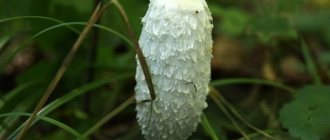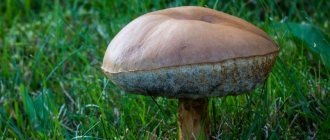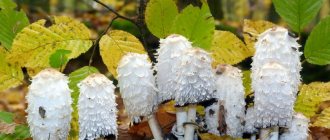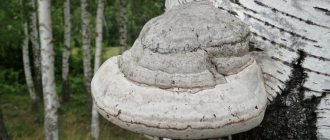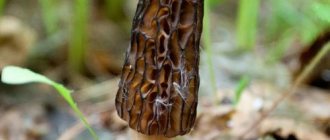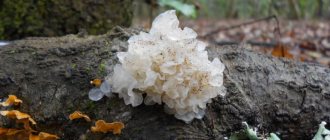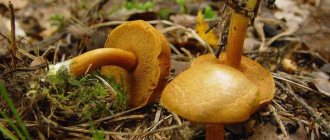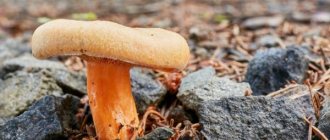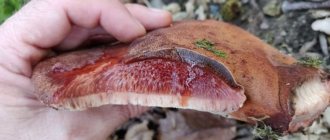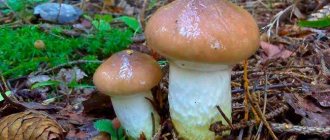Walnut fungi are found mainly on old trees or trees with damaged wood. As a rule, a type of parasitic fungus is found on walnuts, such as scaly tinder fungus, or hare fungus. As for hazel or hazel, this shrub is most often parasitized by fungi of the pyrenomycetes family. In addition, on walnut trunks at home it is possible to grow such common and popular edible mushrooms as oyster mushrooms.
Walnut fungi are found mainly on old trees or trees with damaged wood
Description of the mushroom
If you are a novice mushroom picker, before you go on a “hunt” for thistle, you should carefully read the description and photographs so as not to accidentally confuse it with other, dangerous representatives. At first glance, it looks completely normal, but upon closer examination, some features can be discerned.
What does it look like
The common mushroom is a relatively small mushroom, reaching a maximum height of about 12 cm. It is not so easy to find in the forest, since the color often blends in with the surrounding area. Looking at the photo, you can see that the mushroom has a dryish fleshy cap with a diameter of 5–15 cm. Its shape is different in young and adult representatives: at first it is convex, has a small tubercle in the middle, and in old mushrooms it is spread out with a depressed center.
The edges of the cap are initially tucked in, but with age they straighten out and become thinner. The color ranges from red-yellow to brown-red. In some regions, the mushroom is also called serushka, since its cap has a grayer tint. The leg is thick, sometimes its diameter reaches 4 cm, has a cylindrical shape, smooth or slightly swollen. The height of the stem is 4–10 cm. In young mushrooms it is fleshy, but with age it becomes hollow. To the touch - velvety, smooth. The color of the stem is most often similar to the cap, but a little lighter.
The pulp is dense, but if damaged, it breaks quickly and has a sweetish taste. Another name for thistle is milkweed (euphorbia, molokanka). It is so called because when cut it secretes a milky sap - a white sticky liquid that changes color to brown when exposed to air. The inside of the cap is covered with yellowish or white-pink plates that darken when touched or damaged.
Edible species
According to the data, there are not too many edible varieties of tree mushrooms , but some of them are well known to mushroom pickers and are well-deservedly popular due to their taste and nutritional value.
| Name | Latin | Pulp | hat | Leg |
| Grifola curly | Grifola frondosa | Fibrous, whitish in color, with a pleasant and persistent aroma | Represented by a dense and bushy “pseudo-hat” growth | Light color, quite pronounced |
| Sulfur-yellow mulberry, or chicken mushroom | Laetiporus sulphureus | Elastic and thick, quite juicy when young | Drop-shaped, yellowish in color | Unexpressed, even yellowish color |
| Oyster mushroom | Pleurotus cornucopiae | White in color, fleshy and elastic, without pronounced aroma or taste | Horn-shaped or funnel-shaped, whitish-gray in color | Covered with descending plates, centrally located |
| Scaly polypore | Polyporus squamosus | Quite juicy, quite dense, with a very pleasant aroma | Leathery, yellow, covered with dark brown scales | Shortened, covered with brownish scales |
| Polyporus cellular | Polyporus alveolaris | Harsh, white, with an inexpressive taste and barely noticeable aroma | Semicircular or oval, reddish-yellow, covered with scales | Shortened, lateral, smooth, whitish in color |
| Winter honey fungus | Flammulina velutipes | Whitish, with a delicate taste and a slight mushroom smell | Convex, slippery, brownish, with a dark center | Velvety fleecy type, brown color |
Growing
Today, growing mushrooms in your own garden beds is very popular among gardeners. In addition to the well-known champignons and oyster mushrooms, people have learned to successfully plant other species, such as porcini mushrooms, honey mushrooms, etc. You can also grow thistle at home. However, it is worth noting that the first time a positive result may not be so impressive, since the yield and quality of mushrooms largely depend on natural conditions, proper planting and care.
But, if you get the hang of it over time, you can harvest a decent harvest without going into the wilds of the forest. To grow sweetgrass on your property, you will need to purchase powdered mycelium. It is usually sold in packages per 1 m².
Did you know? The body of the mushroom is considered to be the mycelium, which extends over a long distance in the ground, and the mushroom itself
-
this is just its fruit.
Before sowing, it is mixed with 0.5 kg of dry soil or sand . To plant, you need to select an area near any tree, dig the ground to a depth of about 10 cm, forming a small depression on the surface. Now you need to scatter the mycelium evenly. The top of the planting should be sprinkled with a layer of ordinary garden soil mixed with humus in equal proportions. The bed is watered at the rate of 10 liters of water per 1 m².
The planting must be watered during dry periods, delivering 15–20 liters of settled water per 1 m². The first mushrooms will appear 2.5 months after planting. The harvest will be relatively poor - about 500 g per 1 m². In the future, the bed will yield 4 times a year - 2 times in the fall and 2 times in the spring, delighting its owners with 3-4 kg of fresh tasty mushrooms.
In the intervals between the growth of mushrooms, the ground needs to be fertilized with humus, pouring about 15 kg per 1 m² on top. The mycelium will bear fruit as long as the tree near which it is located lives, i.e. the period can be calculated in years.
How to grow oyster mushrooms on stumps (video)
However, it is necessary to take into account the specifics of eating such fruiting bodies. For example, the conditionally edible sulfur-yellow tinder fungus, which grows on deciduous trees, can be used for food purposes only at a young age. Older, overgrown specimens may have hallucinatory effects or cause quite severe food poisoning. It is also important to note that the most toxic are the fruiting bodies of fungi growing on coniferous wood and old, already decaying specimens.
Benefits of mushroom
The common mushroom is not only tasty, but also a healthy one. To assess its healing properties, it is enough to consider the characteristics of its chemical composition. The pulp contains a lot of biologically active substances that have a positive effect on the human body.
Important! Thistle has no effect on blood sugar levels, so it can be consumed by people suffering from diabetes.
- In particular, it contains such elements as:
- vitamins of groups A, B, C, PP, D - improve immunity, play an important role in the metabolic process, reduce the feeling of fatigue, slow down the aging process;
- sterols - prevent the absorption of cholesterol into the blood;
- cortisol - stabilizes blood pressure, is responsible for maintaining normal glucose levels, causes an adaptive state during stress;
- free amino acids - stimulate the secret activity of the gastric glands;
- tryptophan is a “good mood” hormone, eliminates depression, fatigue, drowsiness, improves the functions of the digestive system;
- arginine - ensures the transport of oxygen to the heart, improves the function of vascular cells, prevents atherosclerosis;
- chitin - has a beneficial effect on the digestion process;
- tyrosine is a natural antidepressant, increases endurance, normalizes metabolism, relieves headaches;
- phosphorus - participates in the process of preserving genetic information, is a building material for teeth and bones, and a source of energy;
- calcium - improves the structure of cell nuclei and membranes, affects blood clotting;
- potassium - supports the functioning of the heart and blood vessels, accelerates the growth of muscle tissue, helps remove toxins from the body;
- sodium - normalizes kidney function, maintains water-salt balance;
- iron - is involved in the transport of oxygen to tissues, organs and systems.
The mushroom is low-calorie (100 g contains only about 20 kcal), is capable of accelerating metabolic processes in the body, and in terms of its nutritional value it serves as a complete meat substitute, so it is often included in the diet of athletes, supporters of proper nutrition, and vegetarians. It is recommended to use milkweed for colds and as a preventive measure, since the product strengthens the body's immune system.
Did you know? Fungal waste is a good stimulator for plant growth. The water in which the mushrooms were washed can be used to water the beds.
Is it possible to eat?
As we wrote above, among the mushrooms growing on trees and stumps, there are those that can be eaten. Although it should be noted that there are much fewer of them than among those that grow in The most famous among the mushrooms found on trunks are This is the popular name for a group of edible mushrooms that belong to various morphological groups. That’s what the mushroom was called – honey fungus,
because most often it grows on living or dead wood, on stumps.
Did you know?
Honey mushroom is an important product for human health.
Thus, it contains microelements involved in hematopoiesis. By consuming 100 g of these mushrooms per day, a person will satisfy his daily need for such important elements as copper and zinc .
The honey mushroom category includes quite a few different mushrooms. They can also disguise inedible specimens, which are called Therefore, it is very important to know the characteristic differences between dangerous and non-dangerous mushrooms. Below we provide photos and descriptions of mushrooms that grow on trees and are most common.
Use in cooking
The common mushroom, as noted earlier, is an edible mushroom that can be consumed after preliminary cooking. Immediately after harvesting, the fruits should be cleared of damaged areas and washed well. You can soak it in water for 30 minutes to completely clean the surface of dirt and sand. Mushrooms are delicious in any form. You can use them to make a delicious roast, julienne, or even simply fry them with onions - such a dish will also be very tasty.
For those who have not tried sweetgrass yet, we advise you to use the following simple recipes:
- Pickled pine nuts. Place freshly peeled pine nuts in boiling water and cook for 5 minutes, remove from heat, and drain the water. Place them in the pan again and cook for another 10 minutes, then drain the water again and put the mushrooms into jars. Prepare the brine: add salt (2.5 tbsp), 8–10 cloves of garlic, 1 tsp to water (2.5 l). black peppercorns, 7 tbsp. l. vinegar, stir, boil for 5 minutes. Pour the resulting brine over the mushrooms and roll up.
- Mushroom soup. Place the pre-boiled hazelnuts in a frying pan with vegetable oil and lightly fry. Add chopped onion and grated carrots here and continue cooking until golden brown. Pour the resulting mass into a saucepan with water (you can use chicken broth), add diced potatoes, add salt and cook for 30 minutes. At the end of cooking, season with chopped herbs.
- Spaghetti with mushrooms. Fry finely chopped onion in a frying pan until transparent. Add chopped, pre-boiled pine nuts, salt and pepper to it. Cook for 15 minutes. Add diced tomatoes and keep on fire for another 5-7 minutes. Separately, boil the spaghetti in salted water and add to the pan with the dressing, stir and heat for 2-3 minutes. If desired, the dish can be sprinkled with cheese and herbs.
Application in medicine
Due to the large accumulation of useful substances, milkweed has found application in medicine. In particular, it is used to make products that prevent the development of rheumatism and inflammation. For people suffering from cancer, traditional healers recommend rubbing fresh mushrooms on the tumor site.
Find out also how to grow porcini mushrooms in pots.
The most commonly used tincture is tincture of hazelnut. It is an effective remedy in the treatment of ailments associated with dilated veins, varicose veins, and hemorrhoids. It is also useful to drink it for colds, sore throat, and otitis media. To make the product, fresh mushrooms are washed, cut into small pieces, placed in a liter jar and filled to the brim with vodka. The container is placed in a dark, cool place for 15 days. The product is then filtered and stored in the refrigerator. Take the tincture twice a day, 1 tsp.
The juice of thistle is used to treat ulcers and acute gastritis. It’s not difficult to prepare: you need to grind freshly picked pine trees (peeled and washed) in a meat grinder and put them on low heat to simmer in their own juice, which will be released during grinding (if it’s not enough, you can add a little water). After 20 minutes, turn off the heat, let the product cool, and then strain, squeezing the mushrooms well. The juice should be taken three times a day, 1 tsp.
Pyrenomycetes and measures to combat them
In addition to the walnut, a shrub of the birch genus, hazel, is common in Eurasia. This type of shrub is most often parasitized by pyrenomycetes fungi. This family includes several species of parasitic fungi, which are characterized by the active release of spores. In addition, pyrenomycetes are distinguished by the fact that during the growing season they infect plants and shrubs with spores, but further development takes place on dead parts of the bush or tree. At this stage, pyrenomycetes often overwinter.
It should be noted that you can encounter pyrenomycetes in the forest or garden at every step; for example, the activity of these parasitic fungi causes:
- dying of tree branches and trunks;
- development of fungi at the site of trunk damage;
- the occurrence of tree diseases such as cancer;
- leaf damage by powdery mildew;
- rotting of seeds and shoots of bushes and trees, etc.
In addition to the walnut, a shrub of the birch genus, hazel, is common in Eurasia. This type of shrub is most often parasitized by pyrenomycetes fungi.
As a rule, hazelnut bushes are susceptible to powdery mildew in the second half of summer. As experienced gardeners advise, damaged leaves and nuts must be treated with a sulfur-lime solution. In addition, colloidal sulfur is actively used to combat fungi that cause powdery mildew.
Mushroom danger
Common mushrooms, like all mushrooms, are considered a rather heavy product that are difficult to digest by the body. For absolutely healthy people, it is safe, even on the contrary, when taken in moderation, no more than 3 times a week, the common nut helps cleanse the body of cholesterol and toxins. Contraindications apply to people suffering from gastrointestinal disorders - they are strictly not recommended to use these plants.
It will be useful for you to know how quickly boletuses grow after rain.
Also, mushroom dishes should not be given to children in any form - their digestive system is still very weak to cope with such products. Pregnant women and nursing mothers should stop eating mushrooms.
To summarize, we can conclude that the common mushroom is a tasty and healthy mushroom, from which you can prepare a variety of dishes and medicinal products. Remember that everything is good in moderation and do not overuse mushrooms, even if they are so tasty that it is difficult to stop.
It all starts with injury
First of all, remember: was there any damage to the tree in the place where the mushrooms were found? Often gardeners do not notice, for example, frost holes, which later become breeding grounds for various infections and are infested with pests, the most insidious of which are ants. They make their nests in such problem areas, for which they widen the cracks. The wood becomes rotten and becomes colonized with fungal mycelium.
This is said so that gardeners can take preventive measures in time: cure the affected tree in order to prevent its further destruction from the slow but destructive effects of fungi. Within 6-8 years from the moment of their discovery, a garden crop may completely disappear if protective measures are not taken.

